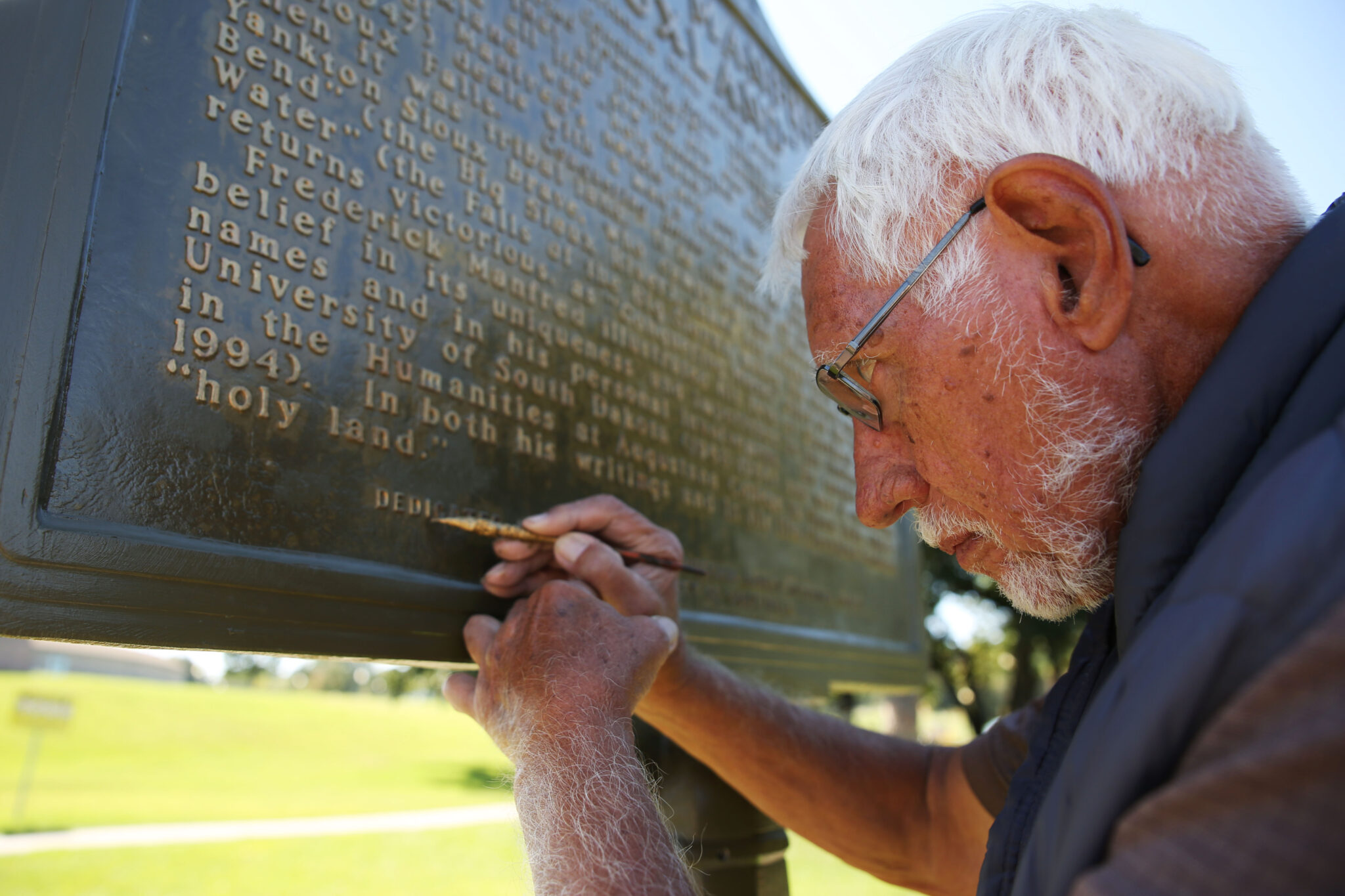
Makenzie Huber/South Dakota Searchlight)
SIOUX FALLS — Jim A. Carlson steadies his hand as he balances on a ladder in Falls Park, concentrating as he paints the raised lettering on a cast aluminum historical marker.
The marker explains how the region earned its “Siouxland” nickname from 20th century author Frederick Manfred. After the marker was erected in 2000, it became discolored and faded within a decade.
Carlson, who’s 84, has volunteered hundreds of hours over the past two summers to refurbish historical markers throughout the Sioux Falls area. So far, he’s touched up 65.
It takes about seven hours to repaint both sides of one sign, he estimates. He cleans and preps it, repaints the base, paints the raised lettering with shimmering gold, and sprays a protectant over the work.
Carlson wipes his hands on a handkerchief when he’s done, though the green and gold has largely dried on his fingertips and nails by then. He loads his ladder, supplies and $12 worth of paint into his red 1998 Ford Ranger pickup and drives to the next sign.
Hundreds of markers statewide
Since 1950, the South Dakota State Historical Society has worked with local sponsors to post over 700 signs memorializing historic events, places and people across the state. Hundreds more have been erected by local organizations. The signs are a draw for tourists curious about South Dakota’s past and an access point to educate residents about state history.

But South Dakota’s harsh winters and blazing summer sun take a toll on the markers, fading and discoloring the signs to the point of illegibility.
The state does not provide funding for the markers. Local organizations such as the Minnehaha County Historical Society pay for the maintenance, and some rely on volunteers including Carlson to do the work.
That can be a difficult task for some local groups. It can cost between $1,300 and $1,700 to have a sign professionally refurbished.
In Vermillion, a resident noticed a historical marker in poor shape. He called several organizations to find out how to refurbish it. He eventually learned that the local Rotary Club was the original sponsor and is responsible for maintaining it.
But the club said it can’t spare the money to refurbish it, so the resident is paying for part of the effort out-of-pocket with a contribution from the club. The Clay County Historic Preservation Commission will consider paying the rest of the money at its December meeting, said Tim Schreiner, commission chair.
State role discussed
The state could play a larger role in communicating with local governments and organizations when a sign is in need of refurbishment, Schreiner said.
Tony Venhuizen, a legislator from Sioux Falls and president of the South Dakota Historical Society Foundation, has helped place several gubernatorial history signs in South Dakota. The foundation is the fundraising arm of the historical society.
Venhuizen said the volunteers who maintain historical markers are doing a great service.

“As a history enthusiast myself, I appreciate the people who value this and put their time and effort into it,” he said.
The foundation is fundraising $4 million to refurbish the state history museum at the Cultural Heritage Center in Pierre. Once that’s completed, Venhuizen said, a fund to help local organizations maintain or refurbish historical signs would be a “great idea to consider at some point.”
“You don’t know where you’re going unless you know where you’ve been,” Venhuizen said. “The neat thing about the markers is you can be in a South Dakota town big or small, you can be driving along a road in the middle of nowhere, and there’s history everywhere.”
In some areas, awareness of local responsibility for the signs has faded. Richard Rubel, vice chairman of the Gregory County Historical Society, said he didn’t know local organizations such as his were responsible for maintaining the markers.
Why it matters
Carlson estimates he’s saved the Minnehaha County Historical Society about $50,000 by refurbishing the signs himself.
He finished his last sign at Falls Park in October. He plans to pick up his work again next spring in downtown Sioux Falls — hopefully with some more volunteers.

Last summer, curious park visitors stopped and watched him as he worked on the signs. Tourists from places as far flung as Asia asked him what he was doing, while others asked about the importance of the history explained on the signs.
“I hope they took more time to read those signs,” Carlson said, “and appreciate our history.”
Schreiner said the signs are an opportunity to learn South Dakota history that’s not always taught in schools or widely known in the state.
“In terms of inspiring somebody or teaching your kids,” Schreiner said, “those quirky little things that inform your sense of where you live are golden.”
